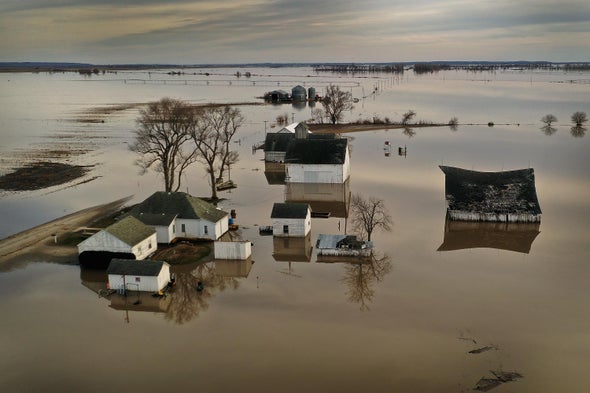
Natural disasters in 2019 were dominated by historic spring flooding that submerged large swaths of the nation, from Louisiana to North Dakota, and by a spate of 10 separate wildfires that broke out across California in October and November.
The events drew attention to two extremes of climate change: prolonged rainfall that flooded the Missouri and Mississippi rivers and prolonged drought that dried California's forests and grasslands into a tinderbox.
The flooding and wildfires also highlighted how well — or poorly — the nation can withstand climate-driven extremes.
First, the good.
The California wildfires became national events when electric utilities shut off power to millions of customers statewide to avoid having downed power lines ignite nearby vegetation. The planned blackouts were part of an effort by California regulators to minimize wildfire death and damage, even if the outages left millions of people and businesses without power for days.
It's hard to draw definitive conclusions about how much this strategy helped. But the destruction caused by wildfires this year dropped significantly.
California wildfires this year killed three people, burned 253,000 acres and destroyed 732 structures, according to the California Department of Forestry and Fire Protection (Cal Fire).
The numbers are minuscule compared with 2017 and 2018, when California wildfires killed a total of 144 people, burned 3.5 million acres and destroyed 36,000 structures, Cal Fire records show.
Bill Johnson, CEO of PG&E Corp., which owns the state's largest utility, said the outages "helped keep people safe."
One environmental group credited communities and the state.
"California residents and firefighters have taken the lessons learned over the last few years to heart," Kristina Dahl, a climate scientist at the Union of Concerned Scientists, wrote in a recent blog post. The state and Sonoma County — the site of some of the state's worst wildfires — "have invested heavily in emergency alert systems since 2017. Prepositioning of firefighting equipment and tireless work by the state's firefighters have been credited with saving an entire town's homes," Dahl wrote.
The wildfires drew attention to climate change, particularly its role in prolonging California's decadelong drought and killing 147 million trees, which have become prime timber.
Johnson of PG&E Corp. publicly blamed climate change for California's wildfires, even as his company agreed to pay $24.5 billion to settle claims that it was responsible for the notorious Camp Fire of 2018, which killed 85 people.
"This is a climate-driven experience," Johnson told the Senate Energy and Natural Resources Committee last week (Climatewire, Dec. 20).
Flood damage was a different story.
As the Missouri, the Mississippi and other rivers reached record heights, dozens of levees put in place to protect residents were breached or overtopped.
A total of 550 counties and 28 American Indian reservations in 19 states were declared flood disasters by the Federal Emergency Management Agency, including almost every county in Iowa, Nebraska and South Dakota.
Members of Congress assailed the Army Corps of Engineers for failing to adequately maintain its network of levees and for not making flood protection a higher priority of river management. Congress gave the Army Corps $3.2 billion in emergency funding in June for repair work and improvements, and last week boosted the agency's annual budget for 2020 by $650 million.
Others say money is not the issue.
"We've got terrible flooding this year," attorney R. Dan Boulware said in a recent interview. "We're flooding every single year, and it's going to continue until and unless Congress does something to restore flood control as the top priority."
Boulware won a lawsuit last year against the Army Corps on behalf of hundreds of Missouri River neighbors who said the agency had failed to protect them and caused millions of dollars of flood damage to their properties.
NOAA blamed the flooding in 2019 on "high rivers, levee failure and persistently heavy rainfall."
Despite the drama of flooding and wildfires, 2019 was an average year for natural disasters in the United States, at least in the context of the elevated number of events in the past two decades.
This year, President Trump declared 61 major disasters — a declaration that entitles states and communities to federal money and help in rebuilding.
The average annual number of major disasters since 1996 is 58. The average number from 1953 to 1995 was 28, FEMA records show.
The bad news for 2019 is that more than one-third of the country was hit by a hurricane, flood, storm, wildfire or tornado severe enough to necessitate federal help.
Disasters and emergencies were declared in 1,210 of the nation's 3,142 counties, an E&E News analysis of FEMA records shows. That's the highest number since 2011. More than 105 million of the nation's 327 million people live in the damaged counties.
California's effectiveness at minimizing wildfire deaths by containing the blazes and evacuating residents helped keep the national death toll from disasters low.
Major U.S. disasters this year have killed 39 people, according to NOAA's database of weather and climate disasters that cause at least $1 billion in damage.
The death toll is the lowest since 2009 and the sixth-lowest since 1980, the NOAA database shows. From 1980 through 2018, major disasters killed an average of 348 people a year.
Deaths were low this year because there were none of the devastating hurricanes or prolonged droughts and heat waves that are the most lethal types of disasters.
The year's deadliest event, Hurricane Dorian, killed 10 people when it hit the southeast Atlantic coast in September.
Dorian was a Category 1 hurricane by the time in made landfall in Florida — much weaker than its Category 5 strength when it demolished the Bahamas, killing 70 people just before reaching the United States.
The 2019 Atlantic hurricane season "featured above normal activity," including 18 named storms, six hurricanes and three major hurricanes that were Category 3 strength or higher, NOAA's National Hurricane Center said. The average Atlantic hurricane season has 12 named storms, six hurricanes and three major hurricanes.